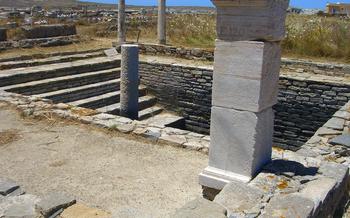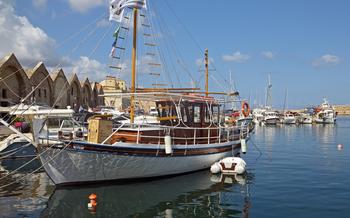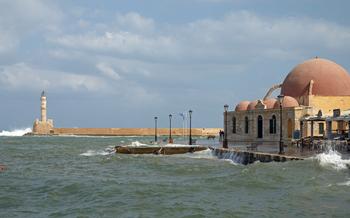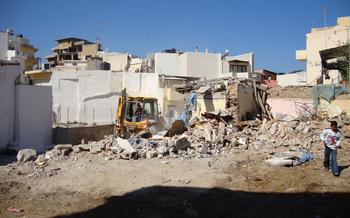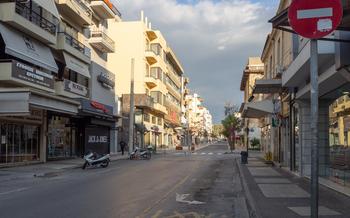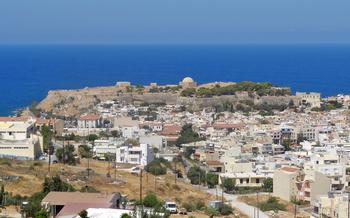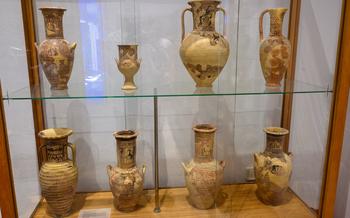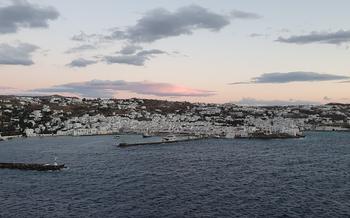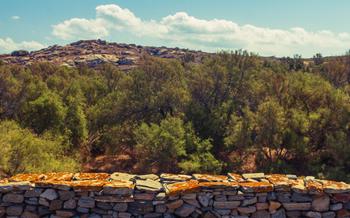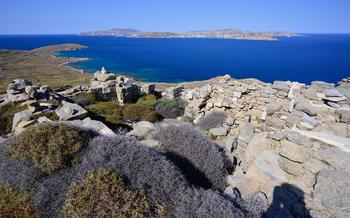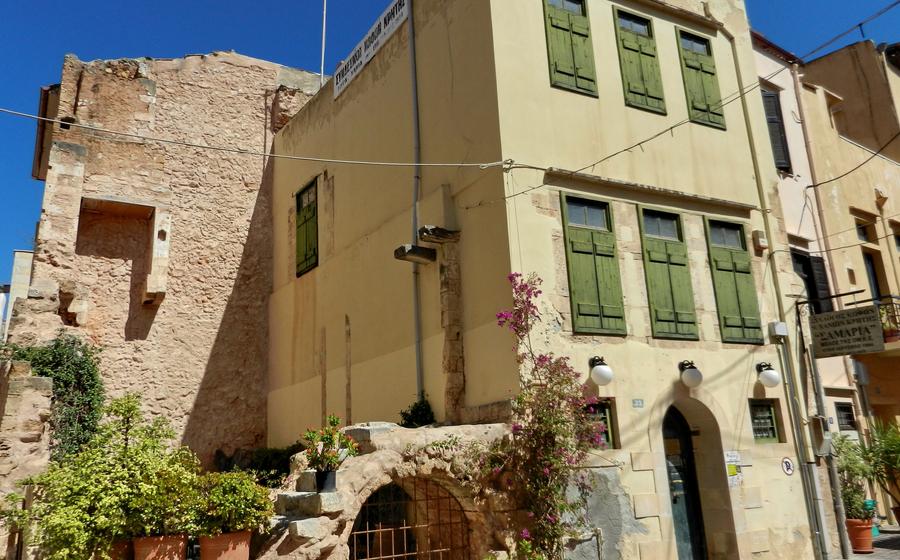
Ancient Polyrinia
- Historical Background
- Getting There
- Exploring the Archaeological Site
- Theater of Polyrinia: A Stage for Ancient Performances
- Workshops and Craftsmen's Quarters
- Residential Areas
- Fortified Walls
- Water Management System
- Olive Oil Production
- Agricultural Practices
- Trade and Commerce
- Social Life and Entertainment
- Insider Tip: Enhancing Your Polyrinia Experience
Historical Background
Polyrinia, an ancient city in Crete, unveils a rich and captivating history, dating back to the Minoan civilization, which flourished in Crete from 2700 to 1450 BC. The Minoans, known for their advanced culture and maritime prowess, established a significant presence in Polyrinia, leaving behind remnants of their civilization that can still be seen today.
In ancient Crete, Polyrinia played a pivotal role as a thriving city-state, engaging in trade and cultural exchanges with neighboring regions. Archaeological discoveries have revealed impressive structures, including a well-preserved theater, temples, and workshops, shedding light on the city's grandeur and importance. Ongoing research continues to uncover fascinating insights into the lives and customs of Polyrinia's inhabitants, providing a glimpse into this ancient city's remarkable past.
Getting There
To embark on your journey to the ancient Polyrinia, embrace the scenic drive nestled amidst the picturesque landscapes of Crete. From the vibrant city of Chania, follow the national road towards Kastelli, a journey spanning approximately 45 kilometers. As you approach Kastelli, locate the signposts directing you towards Polyrinia, leading you along a winding road adorned with olive groves and traditional villages. Embrace the adventure of traversing Crete's interior, where the natural beauty of the countryside harmoniously blends with the allure of ancient history.
For those seeking public transportation, buses offer a convenient and affordable option, linking Chania and Heraklion to Kastelli. From Kastelli, local buses or taxis can be easily arranged to complete the journey to Polyrinia. Alternatively, renting a car grants the ultimate flexibility to explore Polyrinia at your own pace, allowing you to delve deeper into Crete's rich tapestry of historical sites and natural wonders.
To enhance your navigation, we recommend consulting a detailed map or utilizing GPS coordinates. The precise location of Polyrinia is marked as 33406° N, 22883° E, ensuring that you effortlessly discover this hidden gem nestled amidst the idyllic Cretan countryside.
Exploring the Archaeological Site
The ancient city of Polyrinia is a treasure trove of archaeological wonders, offering a glimpse into the lives and culture of its former inhabitants. As you wander through the ruins, you'll discover a carefully planned city with a network of cobbled streets and well-preserved buildings.
At the heart of Polyrinia lies the impressive theater, a testament to the city's cultural significance. Its stone seats, stage, and orchestra pit are remarkably intact, allowing you to imagine the vibrant performances and gatherings that once took place here.
Adjacent to the theater is the Temple of Artemis, dedicated to the Greek goddess of hunting and nature. Its elegant architecture and intricate carvings showcase the artistic prowess of the ancient Polyrinians.
Beyond the theater and temple, you'll find workshops and craftsmen's quarters, where skilled artisans once plied their trade. From pottery and weaving to metalworking and jewelry-making, these workshops were essential to the city's economy and daily life.
Residential areas provide a glimpse into the domestic lives of ordinary citizens. Modest houses with courtyards and storage spaces line the streets, offering insights into the social structure and daily routines of the ancient Polyrinians.
The city's impressive fortifications, with their towering walls and strategic location, speak to the importance of defense in ancient times. Imagine the city under siege, with its brave defenders standing guard against invaders.
Throughout the site, you'll find remnants of the city's ingenious water management system, including aqueducts, cisterns, and drainage channels. These innovations ensured a steady supply of water for agriculture, sanitation, and daily life.
As you explore the ruins of Polyrinia, let your imagination transport you back in time. Picture the bustling streets filled with merchants, artisans, and farmers going about their daily lives. Listen for the echoes of laughter and conversation, the sounds of music and celebrations. Polyrinia was once a vibrant and thriving city, and its ruins offer a unique opportunity to connect with the past.
Theater of Polyrinia: A Stage for Ancient Performances
Nestled amidst the ruins of Polyrinia lies a remarkable testament to the city's cultural heritage - the ancient theater. Carved into the hillside, this impressive structure once hosted a variety of performances and events, entertaining and educating the citizens of Polyrinia.
The theater's design reflects the architectural prowess of the ancient Greeks. Its horseshoe-shaped auditorium, capable of accommodating hundreds of spectators, rises in tiers, ensuring optimal acoustics and unobstructed views of the stage. The stage itself, adorned with intricate carvings and colorful frescoes, provided a dynamic backdrop for theatrical productions.
Imagine the vibrant atmosphere during ancient festivals, as the theater filled with eager spectators. The air buzzed with anticipation as actors, musicians, and dancers took to the stage, captivating the audience with their performances. Comedies, tragedies, and musical spectacles brought laughter, tears, and awe to the hearts of those who witnessed them.
Beyond entertainment, the theater served as a venue for religious rituals, civic gatherings, and philosophical discussions. It was a place where ideas were exchanged, stories were told, and the community came together to celebrate their shared culture and heritage.
Workshops and Craftsmen's Quarters
In the heart of ancient Polyrinia, nestled among the residential areas, lay the vibrant workshops and craftsmen's quarters. These bustling streets were a testament to the city's thriving economy and the ingenuity of its artisans. Potters, weavers, metalworkers, and other skilled craftspeople plied their trades, creating goods that were not only essential for daily life but also objects of beauty and artistry.
The potters of Polyrinia were renowned for their exquisite ceramics, crafting elegant vases, amphorae, and intricate figurines. Their kilns, scattered throughout the city, emitted a constant glow, a symbol of their tireless industry. The weavers, with deft hands, transformed colorful threads into intricate tapestries, garments, and carpets, adding a touch of warmth and elegance to Polyrinian homes.
Metalworkers, using their mastery of fire and hammer, forged tools, weapons, and decorative objects from bronze, iron, and gold. The sound of their anvils rang through the streets, a rhythmic beat that echoed the city's vitality. These skilled artisans not only provided essential goods for the community but also contributed to Polyrinia's reputation as a center of craftsmanship and creativity.
As you wander through the ancient workshops, imagine the bustling activity that once filled these spaces. Picture the potters carefully shaping clay on their wheels, the weavers meticulously threading their looms, and the metalworkers skillfully hammering their creations into form. The air would have been filled with the sounds of industry, the smell of burning clay, and the joyous chatter of artisans sharing ideas and stories.
Residential Areas
Unveiling the private lives of Polyrinia's inhabitants, the residential areas offer a glimpse into the daily routines and social structure of the ancient city. Meandering through the narrow cobblestone streets, visitors can explore the remnants of houses, each telling a unique story. The houses, constructed of local stone, feature simple yet functional designs, often comprising several rooms arranged around a central courtyard.
Imagine the warmth of a family gathered around the hearth, preparing traditional Cretan dishes in the kitchen, or children playing in the courtyard, their laughter echoing through the neighborhood. The layout of the houses reveals a strong sense of community, with shared walls and communal spaces fostering a close-knit social fabric.
Unearthing the secrets of these domestic spaces, archaeologists have discovered various artifacts that shed light on the daily lives of Polyrinia's residents. From cooking utensils and pottery fragments to tools and personal belongings, these remnants provide tangible evidence of the city's vibrant domestic culture.
Strolling through the residential quarters, visitors can almost hear the hum of daily life, the sound of looms weaving intricate textiles, the clatter of pottery workshops, and the laughter of children playing traditional games. These ancient streets, once filled with life, offer a profound connection to the human history that shaped Polyrinia.
Fortified Walls
In a world marred by conflict and uncertainty, the ancient city of Polyrinia recognized the paramount importance of defense. Its formidable walls, constructed with meticulous precision and unwavering resolve, served as an impenetrable barrier against would-be invaders. These towering fortifications, crafted from colossal stone blocks, encircled the city like an unyielding embrace, symbolizing the resilience and determination of its inhabitants.
Strategically positioned atop a hill overlooking the surrounding landscape, Polyrinia's walls provided a tactical advantage, allowing its defenders to survey the terrain and swiftly respond to any threat. The sheer height and thickness of the fortifications made them virtually impregnable, a testament to the engineering prowess of the ancient Polyrinians.
Massive gates, adorned with intricate carvings depicting scenes of triumph and valor, served as the sole entry and exit points to the city. These gates were meticulously guarded by seasoned warriors, ensuring that only authorized individuals gained access. Drawbridges, suspended over deep moats, added an extra layer of protection, creating a formidable obstacle for any potential intruders.
As the sun cast its golden rays upon the city, the fortified walls of Polyrinia stood tall and proud, a silent testament to the unwavering spirit of its people. They represented not just a physical barrier but also a symbol of unity, strength, and defiance against any force that dared to challenge their sovereignty.
Water Management System
The ancient Polyrinians demonstrated remarkable ingenuity in managing their water resources. They constructed an elaborate system of aqueducts, cisterns, and drainage systems to ensure a reliable water supply for the city.
The aqueducts, expertly engineered channels, transported water from distant springs and rivers to the city. These channels were carefully designed to maintain a steady flow of water, even during droughts. Once inside the city, the water was stored in large underground cisterns, ensuring a reserve during periods of low rainfall.
The drainage system was equally impressive. Carefully constructed channels and pipes collected rainwater and wastewater from the streets and buildings, preventing flooding and maintaining sanitation. This system not only ensured the cleanliness of the city but also helped prevent the spread of diseases.
The water management system of ancient Polyrinia was a testament to the city's advanced engineering skills and their understanding of the importance of water for agriculture, sanitation, and daily life. It is a reminder of the ingenuity and resourcefulness of the ancient Minoan civilization.
Olive Oil Production
Olive oil was a vital commodity in ancient Crete, and Polyrinia was no exception. The city's fertile lands and favorable climate made it an ideal location for olive cultivation. Olive trees were carefully tended and harvested, and the oil was extracted using traditional methods. The process involved crushing the olives into a paste, then pressing the paste to separate the oil from the solids.
The resulting oil was used for various purposes, including cooking, lighting, and religious rituals. It was also an important trade item, exported to other regions of the Mediterranean. The production of olive oil brought wealth and prosperity to Polyrinia, and it remains an essential part of the local economy today.
One of the most fascinating aspects of olive oil production in ancient Polyrinia is the use of traditional methods. The olives were harvested by hand, and the oil was extracted using simple tools such as stone mortars and presses. This process has remained largely unchanged for centuries, and visitors to Polyrinia can still witness these traditional techniques being used.
If you're interested in learning more about olive oil production in ancient Crete, be sure to visit the local olive oil museum. The museum houses a collection of artifacts and displays that illustrate the history and process of olive oil production. You can also sample some of the delicious olive oil produced in Polyrinia today.
Agricultural Practices
In ancient Polyrinia, agriculture played a vital role in sustaining the city's population. The fertile soil and favorable climate of the region allowed farmers to cultivate a variety of crops, including wheat, barley, olives, grapes, and vegetables. These crops provided the foundation of the city's food supply, ensuring that the inhabitants had enough to eat throughout the year.
Farming techniques in ancient Polyrinia were relatively advanced for their time. Farmers used a combination of irrigation and dry farming methods to maximize their crop yields. They also employed crop rotation and fertilization techniques to maintain soil fertility. These practices allowed them to produce a surplus of food, which could be traded with other cities and regions.
One of the most important crops cultivated in ancient Polyrinia was the olive tree. Olive oil was a valuable commodity, used for cooking, lighting, and religious rituals. The cultivation of olives was a labor-intensive process, but it was also very profitable. Olive oil was exported to other parts of Crete and beyond, bringing wealth and prosperity to the city.
Agriculture in ancient Polyrinia was not without its challenges. Farmers had to contend with droughts, floods, and pests. They also had to protect their crops from wild animals and marauding armies. Despite these challenges, the farmers of Polyrinia were able to produce enough food to sustain the city's population and contribute to its economic prosperity.
Trade and Commerce
Polyrinia's strategic location on the northern coast of Crete made it a hub for trade and commerce in ancient times. The city's harbor was a bustling center of activity, with ships arriving from across the Mediterranean Sea, bringing goods from far-off lands. Polyrinia exported its own products, such as olive oil, wine, and pottery, and imported a wide range of goods, including metals, textiles, and spices.
The city's marketplaces were a hive of activity, with merchants from all over the region gathering to buy and sell their wares. The markets were also a place for social interaction and entertainment. People would come to trade, gossip, and catch up on the latest news.
Polyrinia's wealth and prosperity were largely due to its strategic location and its thriving trade. The city was able to maintain its independence and autonomy for many centuries, thanks to its strong economy and its ability to control its own trade routes.
Social Life and Entertainment
The social fabric of ancient Polyrinia was vibrant and diverse. The city's inhabitants celebrated life with numerous festivals, feasts, and gatherings. These events provided opportunities for socializing, entertainment, and strengthening community bonds.
One of the most significant festivals was the annual celebration of the goddess Artemis, the city's patron deity. During this festival, the streets of Polyrinia would come alive with processions, music, dancing, and theatrical performances. Citizens from neighboring towns and villages would join in the festivities, creating a lively and joyous atmosphere.
Theater played a crucial role in the social and cultural life of Polyrinia. The city's well-preserved theater hosted a variety of performances, including tragedies, comedies, and musical productions. These performances were not merely entertainment but also served as a means of education and social commentary.
Music and dance were integral parts of Polyrinian culture. Skilled musicians and dancers performed at festivals, weddings, and other social gatherings. The rhythmic beats of drums, the enchanting melodies of lyres, and the graceful movements of dancers created a captivating spectacle that delighted audiences.
Taverns and marketplaces were popular meeting places where people could socialize, exchange news, and enjoy a drink or a meal. These establishments were often the scene of lively conversations, laughter, and storytelling, fostering a sense of community and camaraderie.
Intimate gatherings were also common among Polyrinia's residents. Families and friends would gather in homes or gardens to share meals, play games, and engage in stimulating conversations. These gatherings provided a space for relaxation, bonding, and the sharing of stories and experiences.
Insider Tip: Enhancing Your Polyrinia Experience
For an unforgettable experience, visit Polyrinia during the summer months when the weather is ideal for exploring the ancient city. The warm sunshine illuminates the ruins, casting intricate shadows that bring the past to life. Immerse yourself in the history and culture of ancient Greece as you wander through the streets and admire the well-preserved structures.
Combine your visit to Polyrinia with a trip to the nearby Elafonisi Beach, renowned for its pink sands and crystal-clear waters. This stunning beach offers a refreshing contrast to the historical ruins, allowing you to experience the natural beauty of Crete.
To delve deeper into the history of Polyrinia, consider booking a guided tour. Knowledgeable guides can provide fascinating insights into the city's past, bringing the ruins to life with their stories and explanations. Local guides often have unique perspectives and can share anecdotes that make the experience even more engaging.
Don't miss the opportunity to savor the local cuisine while in Polyrinia. Traditional Cretan dishes, such as "dakos" (barley rusk with tomatoes, feta cheese, and olive oil) and "gamopilafo" (wedding pilaf), offer a taste of the region's rich culinary heritage. Indulge in the flavors and aromas of Crete as you dine in one of the charming tavernas or restaurants in the area.
Plan your trip to Polyrinia with these insider tips, and you'll discover a truly immersive and memorable experience that will transport you back in time to ancient Greece.
